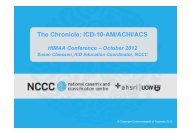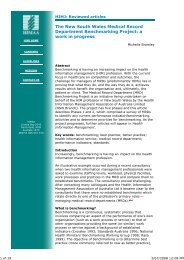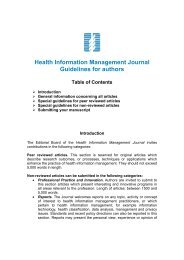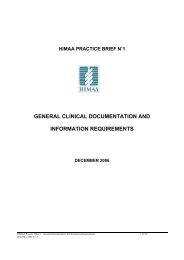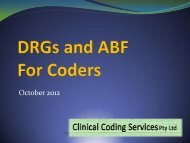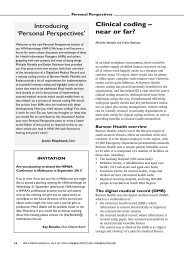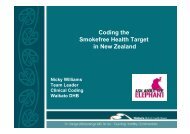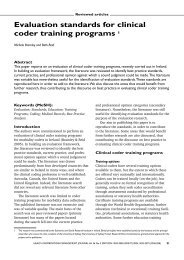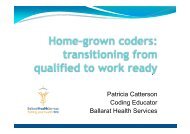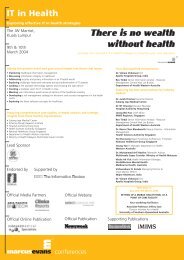Coding and DRG relationships in stroke and transient ischaemic attack
Coding and DRG relationships in stroke and transient ischaemic attack
Coding and DRG relationships in stroke and transient ischaemic attack
Create successful ePaper yourself
Turn your PDF publications into a flip-book with our unique Google optimized e-Paper software.
Reviewed articles<br />
<strong>Cod<strong>in</strong>g</strong> <strong>and</strong> <strong>DRG</strong> <strong>relationships</strong> <strong>in</strong><br />
<strong>stroke</strong> <strong>and</strong> <strong>transient</strong> <strong>ischaemic</strong> <strong>attack</strong><br />
(TIA)<br />
Shyamala Nadathur <strong>and</strong> Andrea Groom<br />
Abstract<br />
The selection of cohorts from national <strong>and</strong> state databases <strong>in</strong> Australia usually relies on patient<br />
diagnoses accord<strong>in</strong>g to International Classifi cation of Disease (ICD) codes <strong>and</strong>/or Diagnosis Related<br />
Groups (<strong>DRG</strong>s). The aim of this study was to select a specifi c cohort consist<strong>in</strong>g of <strong>stroke</strong> <strong>and</strong> <strong>transient</strong><br />
<strong>ischaemic</strong> <strong>attack</strong> (TIA) episodes, thereby allow<strong>in</strong>g the researcher to exam<strong>in</strong>e current process of care<br />
us<strong>in</strong>g State level hospital admissions datasets. Diffi culties <strong>in</strong> accurately select<strong>in</strong>g the specifi ed cohort<br />
were encountered, due to various <strong>in</strong>terpretations of ICD codes <strong>and</strong> <strong>DRG</strong>s as well as the placement of<br />
codes to <strong>DRG</strong>s <strong>and</strong> different classifi cations used. These diffi culties highlighted several issues regard<strong>in</strong>g<br />
the <strong>relationships</strong> between ICD cod<strong>in</strong>g <strong>and</strong> <strong>DRG</strong>s <strong>in</strong> <strong>stroke</strong> <strong>and</strong> TIA <strong>and</strong> are the focus of this paper.<br />
Keywords (MeSH):<br />
Cerebrovascular accident; ischemic <strong>attack</strong>, <strong>transient</strong>; International Classification of Diseases; Diagnosis-<br />
Related Groups; hospital records; medical records<br />
Introduction<br />
Rout<strong>in</strong>ely collected State-wide <strong>and</strong> national<br />
datasets of hospital admissions are <strong>in</strong>creas<strong>in</strong>gly<br />
be<strong>in</strong>g used for epidemiological, quality of care,<br />
benchmark<strong>in</strong>g <strong>and</strong> cost studies (Roos, Menec &<br />
Currie 2004; Scott, Youlden & Coory 2004). The<br />
selection of cohorts from these datasets usually<br />
relies on Diagnosis Related Groups (<strong>DRG</strong>s)<br />
(Kugler et al. 2000; Evers et al. 2002) <strong>and</strong>/or<br />
the patient diagnoses as classified accord<strong>in</strong>g to<br />
International Classification of Disease (ICD) codes<br />
(Ellekjaer et al. 1999; Lee, Somerford & Yau<br />
2003).<br />
<strong>DRG</strong>s are a means of classify<strong>in</strong>g a variety of<br />
diagnoses <strong>and</strong> procedures ICD codes <strong>in</strong>to groups.<br />
One of the three ma<strong>in</strong> criteria of a <strong>DRG</strong> classification<br />
system is that the episodes <strong>in</strong> each <strong>DRG</strong><br />
are cl<strong>in</strong>ically mean<strong>in</strong>gful – that is, the diagnostic<br />
cluster should be cl<strong>in</strong>ically significant. Therefore,<br />
it is not unreasonable to expect that, for <strong>in</strong>stance,<br />
a selection of ‘<strong>stroke</strong>’ <strong>and</strong> ‘<strong>transient</strong> <strong>ischaemic</strong><br />
<strong>attack</strong>’ (TIA) <strong>DRG</strong>s, <strong>and</strong> hence the codes<br />
conta<strong>in</strong>ed with<strong>in</strong> them, would provide all of the<br />
relevant admissions from the dataset.<br />
This paper reports the problems encountered<br />
<strong>in</strong> the selection of the cohort for an analysis of<br />
<strong>stroke</strong> <strong>and</strong> TIA process of care <strong>in</strong> acute hospitals<br />
us<strong>in</strong>g multiple year, state-level, hospital admissions<br />
datasets. The issues discussed here <strong>in</strong>clude<br />
discrepancies <strong>in</strong> how ICD codes are classified to<br />
<strong>stroke</strong> <strong>and</strong> TIA <strong>DRG</strong>s; work<strong>in</strong>g with several <strong>DRG</strong><br />
classifications with different axes; <strong>and</strong> coder<br />
variance <strong>in</strong> the selection of ICD codes <strong>and</strong> <strong>DRG</strong>s<br />
for <strong>stroke</strong> <strong>and</strong> TIA. The latest version of the <strong>DRG</strong><br />
was checked for amendments that correct some of<br />
the reported <strong>in</strong>consistencies.<br />
Method<br />
The Victorian Admitted Episodes Dataset (VAED)<br />
for the f<strong>in</strong>ancial years 1999/2000, 2000/2001<br />
<strong>and</strong> 2001/2002 was the source of the cohort of<br />
<strong>stroke</strong> <strong>and</strong> TIA for the study. For the purpose<br />
of this study <strong>stroke</strong> syndrome is def<strong>in</strong>ed as ‘a<br />
symptom complex caused by a disorder of the<br />
blood vessels serv<strong>in</strong>g the bra<strong>in</strong>, with impaired<br />
blood supply <strong>and</strong> ischaemia…called also <strong>stroke</strong>,<br />
cerebral vascular accident, <strong>and</strong> cerebrovascular<br />
accident’ (O’Toole, 1992: p. 1424). A <strong>transient</strong><br />
38 HEALTH INFORMATION MANAGEMENT Vol 35 No 1 2006 ISSN 1833-3583 (PRINT) ISSN 1833-3575 (ONLINE)
Reviewed articles<br />
<strong>ischaemic</strong> <strong>attack</strong> is def<strong>in</strong>ed as a temporary <strong>attack</strong>,<br />
often a precursor to a <strong>stroke</strong> (O’Toole 1992).<br />
For this study, <strong>stroke</strong> <strong>and</strong> TIA ICD codes <strong>and</strong><br />
<strong>DRG</strong>s were selected <strong>in</strong> consultation with cl<strong>in</strong>icians<br />
<strong>and</strong> coders. As <strong>DRG</strong>s should represent<br />
cl<strong>in</strong>ically significant clusters, first the coders<br />
were asked to select the relevant ‘<strong>stroke</strong>’ <strong>and</strong> ‘TIA’<br />
<strong>DRG</strong>s. Second, the ICD codes <strong>in</strong>cluded with<strong>in</strong><br />
these <strong>DRG</strong>s were reviewed with cl<strong>in</strong>icians for face<br />
validity. It was recognised that the first two steps<br />
did not provide a complete list <strong>and</strong> so step three<br />
was applied, whereby all relevant <strong>stroke</strong> <strong>and</strong> TIA<br />
ICD codes were selected <strong>in</strong> consultation with<br />
coders <strong>and</strong> cl<strong>in</strong>icians. ICD-9-CM codes selected<br />
were also mapped to the equivalent ICD-10-AM<br />
code. A fourth step was required to determ<strong>in</strong>e the<br />
<strong>DRG</strong>s for the codes <strong>in</strong> step three.<br />
Three <strong>DRG</strong> versions were used dur<strong>in</strong>g the<br />
study timeframe, namely (v) 3.1 (Commonwealth<br />
Department of Health <strong>and</strong> Family Services 1996),<br />
4.1 (Commonwealth Department of Health<br />
<strong>and</strong> Aged Care 1998) <strong>and</strong> 4.2 (Commonwealth<br />
Department of Health <strong>and</strong> Aged Care 2000). The<br />
AR-<strong>DRG</strong> v4.1 classifies <strong>stroke</strong> patients <strong>in</strong>to four<br />
<strong>DRG</strong>s rather than the two found <strong>in</strong> v3.1 (namely<br />
<strong>DRG</strong> 37 <strong>and</strong> 38 ‘Cerebrovascular disorder except<br />
TIA’). With<strong>in</strong> version 4.1 the groups <strong>in</strong>clude B70A<br />
‘Stroke with severe or complicat<strong>in</strong>g diagnosis/<br />
procedure’, B70B ‘Stroke with other complication<br />
or comorbidity’, B70C ‘Stroke without other<br />
complication or comorbidity’ <strong>and</strong> B70D ‘Stroke<br />
died or transferred < 5 days’. <strong>DRG</strong> 37 of v3.1<br />
has been reclassified <strong>in</strong>to B70A <strong>and</strong> B70B, <strong>and</strong><br />
<strong>DRG</strong> 38 maps to B70C. TIA patients are classified<br />
to <strong>DRG</strong>s 67, 68 <strong>and</strong> 69 ‘TIA <strong>and</strong> precerebral<br />
occlusion’ <strong>in</strong> AN-<strong>DRG</strong> v3.1; <strong>and</strong> adjacent <strong>DRG</strong><br />
B69 ‘TIA <strong>and</strong> precerebral occlusion’ <strong>in</strong> AR-<strong>DRG</strong><br />
v4.1 <strong>and</strong> v4.2.<br />
The study years covered three cod<strong>in</strong>g classifications:<br />
the Official National <strong>Cod<strong>in</strong>g</strong> Centre<br />
(NCC) Australian version of ICD-9-CM, Second<br />
Edition (National <strong>Cod<strong>in</strong>g</strong> Centre 1996); ICD-<br />
10-AM, First Edition (National Centre for<br />
Classification <strong>in</strong> Health 1998) <strong>and</strong> Second Edition<br />
(National Centre for Classification <strong>in</strong> Health<br />
2000).<br />
To relate the ICD <strong>and</strong> <strong>DRG</strong> classifications with<br />
the datasets, the 1999/2000 dataset reflects ICD-<br />
9-CM <strong>and</strong> AN-<strong>DRG</strong> v.3.1; the 2000/2001 dataset<br />
reflects ICD-10-AM First Edition <strong>and</strong> AR-<strong>DRG</strong><br />
v4.1; <strong>and</strong> the 2001/2002 dataset reflects ICD-10-<br />
AM Second Edition <strong>and</strong> AR-<strong>DRG</strong> v.4.2.<br />
At the conclusion of the study, the latest<br />
version of the <strong>DRG</strong> (AR-<strong>DRG</strong> v5.0) was also<br />
checked for amendments that would correct some<br />
of the reported <strong>in</strong>consistencies.<br />
Results<br />
The issues encountered when choos<strong>in</strong>g <strong>stroke</strong> <strong>and</strong><br />
TIA codes <strong>and</strong> the relevant <strong>DRG</strong>s are listed below.<br />
Codes not represent<strong>in</strong>g ‘<strong>stroke</strong>’ found <strong>in</strong> AR-<strong>DRG</strong><br />
v4 <strong>and</strong> v5.0 <strong>stroke</strong> <strong>DRG</strong>s<br />
In the <strong>stroke</strong> <strong>DRG</strong>s there were ICD codes not<br />
describ<strong>in</strong>g <strong>stroke</strong>, such as ‘Encephalopathy’<br />
(G93.4), ‘Other specified disorders of bra<strong>in</strong>’<br />
(G93.8) <strong>and</strong> ‘Disorders of bra<strong>in</strong>, unspecified’<br />
(G93.9). Table 1 (below) lists non-<strong>stroke</strong> codes <strong>in</strong><br />
<strong>stroke</strong> <strong>DRG</strong>s.<br />
Table 1: Non-<strong>stroke</strong> codes <strong>in</strong> AR-<strong>DRG</strong> v4 <strong>and</strong> v5.0 <strong>stroke</strong> <strong>DRG</strong>s<br />
<strong>DRG</strong> VERSIONS<br />
CODE DESCRIPTION (ICD-10-AM) V4.1 V4.2 V5.0<br />
Other systemic atrophy affect<strong>in</strong>g CNS <strong>in</strong> neoplastic disease (G13.1) B70 Stroke B70 Stroke B70 Stroke<br />
Transient global amnesia (G45.4) B70 Stroke B70 Stroke B70 Stroke<br />
Encephalopathy unspecifi ed (G93.4)<br />
Other specifi ed disorders of bra<strong>in</strong> (G93.8)<br />
Disorders of bra<strong>in</strong> unspecifi ed (G93.9)<br />
B70 Stroke<br />
Other specifi ed disorders of the CNS (G96.8)<br />
Diseases of the CNS NOS (G96.9)<br />
B70 Stroke<br />
Other disorders of the nervous system, not elsewhere classifi ed (G98)<br />
B70 Stroke<br />
Occlusion <strong>and</strong> stenosis of cerebral arteries,<br />
not result<strong>in</strong>g <strong>in</strong> cerebral <strong>in</strong>farction (I66.x) B70 Stroke B70 Stroke B70 Stroke<br />
Cerebral aneurysm, non ruptured (I67.1)<br />
Cerebral atherosclerosis (I67.2) B70 Stroke B70 Stroke B70 Stroke<br />
Other specifi ed cerebrovascular diseases (I67.8)<br />
Cerebrovascular disease, unspecifi ed (I67.9) B70 Stroke B70 Stroke B70 Stroke<br />
HEALTH INFORMATION MANAGEMENT Vol 35 No 1 2006 ISSN 1833-3583 (PRINT) ISSN 1833-3575 (ONLINE) 39
Reviewed articles<br />
Codes represent<strong>in</strong>g ‘<strong>stroke</strong>’ <strong>in</strong> non-<strong>stroke</strong> AN-<strong>DRG</strong><br />
v3.1 <strong>DRG</strong>s<br />
In AN-<strong>DRG</strong> v3.1, the category ‘Occlusion <strong>and</strong><br />
stenosis of pre-cerebral arteries’ (433.xx) was<br />
classified to non-<strong>stroke</strong> <strong>DRG</strong>s (i.e. <strong>DRG</strong> 67/68/69<br />
which is TIA & Pre-cerebral occlusion). The above<br />
code category <strong>in</strong>cludes occlusion <strong>and</strong> stenosis<br />
both with <strong>and</strong> without <strong>in</strong>farction. This dist<strong>in</strong>ction<br />
is determ<strong>in</strong>ed by the 5th digits of ‘0 without<br />
mention of cerebral <strong>in</strong>farction’ or ‘1 with cerebral<br />
<strong>in</strong>farction’.<br />
Stroke ICD code not <strong>in</strong> AR-<strong>DRG</strong> v4 <strong>stroke</strong> <strong>DRG</strong><br />
The <strong>stroke</strong> code ‘Cerebral <strong>in</strong>farction due to<br />
cerebral venous thrombosis, non-pyogenic’<br />
(I63.6) is <strong>in</strong> a non-<strong>stroke</strong> <strong>DRG</strong> <strong>in</strong> v4 of the<br />
grouper.<br />
Other anomalous ICD code placement<br />
The ICD-10-AM code I67.0, ‘Dissection of cerebral<br />
arteries, non-ruptured’, whilst not considered<br />
to be a ‘<strong>stroke</strong>’, currently groups to ‘Coronary<br />
atherosclerosis’ (i.e. <strong>DRG</strong> F66).<br />
Code concepts different between ICD-9-CM <strong>and</strong><br />
ICD-10-AM<br />
Aetiology/manifestation convention (also known<br />
as dagger/asterisk codes) did not exist as such<br />
<strong>in</strong> ICD-9-CM. This convention was modified to<br />
remove duplication <strong>and</strong> <strong>in</strong>clude, where possible,<br />
fifth digit codes <strong>in</strong> aetiology rubrics, i.e. both<br />
concepts were <strong>in</strong>cluded <strong>in</strong> one code, rather than<br />
two. The aetiology/manifestation convention<br />
was re-<strong>in</strong>troduced <strong>in</strong> ICD-10-AM. Cerebral artery<br />
syndromes (G46.0/1/2) <strong>and</strong> <strong>stroke</strong> <strong>and</strong> lacunar<br />
syndromes (G46.3/4/5/6) are examples of such<br />
ICD-10-AM additions.<br />
Another complication was that different axes<br />
between versions existed, such as the specification<br />
of the artery <strong>in</strong> a cerebral <strong>in</strong>farction due to<br />
occlusion <strong>and</strong> stenosis of pre-cerebral arteries <strong>in</strong><br />
ICD-9-CM, but the specification <strong>in</strong> ICD-10-AM<br />
was the cause; see the example of thrombosis or<br />
embolism below.<br />
<strong>Cod<strong>in</strong>g</strong> conventions not always reflected <strong>in</strong><br />
grouper<br />
It was found that several codes that were <strong>in</strong>valid<br />
as pr<strong>in</strong>cipal diagnosis accord<strong>in</strong>g to cod<strong>in</strong>g<br />
convention grouped to valid <strong>DRG</strong>s. Examples<br />
are aetiology/manifestation comb<strong>in</strong>ations <strong>and</strong><br />
sequela codes. See Table 2.<br />
Coder groups selected different ICD code ranges<br />
Different coders identified different ICD code<br />
ranges for ‘<strong>stroke</strong>’. Table 3 displays the different<br />
ICD code ranges selected by coder groups<br />
Discussion<br />
At first, <strong>DRG</strong>s were used <strong>in</strong> select<strong>in</strong>g ‘<strong>stroke</strong>’ <strong>and</strong><br />
‘TIA’ as <strong>DRG</strong>s are a patient classification scheme<br />
that is said to provide a cl<strong>in</strong>ically mean<strong>in</strong>gful<br />
way of relat<strong>in</strong>g the number <strong>and</strong> types of patients<br />
treated <strong>in</strong> a hospital to the resources required<br />
by the hospital. AN-<strong>DRG</strong> v3.1 37/38 (‘Cerebrov-<br />
Example of thrombosis or embolism<br />
ICD-9-CM (NCC, 1996):<br />
433.0x Occlusion <strong>and</strong> stenosis of pre-cerebral arteries, basilar artery<br />
433.1x Occlusion <strong>and</strong> stenosis of pre-cerebral arteries, carotid artery<br />
433.2x Occlusion <strong>and</strong> stenosis of pre-cerebral arteries, vertebral artery<br />
433.3x Occlusion <strong>and</strong> stenosis of pre-cerebral arteries, multiple <strong>and</strong> bilateral artery<br />
433.8x Occlusion <strong>and</strong> stenosis of pre-cerebral arteries, other specifi ed pre-cerebral artery<br />
433.9x Occlusion <strong>and</strong> stenosis of pre-cerebral arteries, unspecifi ed pre-cerebral artery<br />
5th digit:<br />
0 without mention of cerebral <strong>in</strong>farction<br />
1 with mention of cerebral <strong>in</strong>farction<br />
ICD-10-AM (NCCH, 1998; NCCH, 2000):<br />
I63.0 Cerebral <strong>in</strong>farction due to thrombosis of pre-cerebral arteries<br />
I63.1 Cerebral <strong>in</strong>farction due to embolism of pre-cerebral arteries<br />
I63.2 Cerebral <strong>in</strong>farction due to unspecifi ed occlusion or stenosis of pre-cerebral arteries<br />
40 HEALTH INFORMATION MANAGEMENT Vol 35 No 1 2006 ISSN 1833-3583 (PRINT) ISSN 1833-3575 (ONLINE)
Reviewed articles<br />
Table 2: Examples of where cod<strong>in</strong>g conventions are not reflected <strong>in</strong> grouper<br />
<strong>DRG</strong> VERSIONS<br />
CODE DESCRIPTION(ICD-10-AM, ICD-9-CM) V3.1 V4.1 V4.2 V5.0<br />
Other systemic atrophy affect<strong>in</strong>g CNS <strong>in</strong> neoplastic disease (G13.1) B70 Stroke B70 Stroke B70 Stroke<br />
Middle cerebral artery syndrome (G46.0) B69 TIA <strong>and</strong> B69 TIA <strong>and</strong> B69 TIA <strong>and</strong><br />
Anterior cerebral artery syndrome (G46.1) precerebral precerebral precerebral<br />
Posterior cerebral artery syndrome (G46.2) occlusion occlusion occlusion<br />
Bra<strong>in</strong> stem <strong>stroke</strong> syndrome (G46.3) B70 Stroke B70 Stroke B70 Stroke<br />
Cerebellar <strong>stroke</strong> syndrome (G46.4)<br />
Pure motor lacunar syndrome (G46.5)<br />
Pure sensory lacunar syndrome (G46.6)<br />
Other lacunar syndromes (G46.7) B70 Stroke B70 Stroke B70 Stroke<br />
Other vascular syndromes of bra<strong>in</strong> <strong>in</strong> cerebrovascular diseases (G46.8)<br />
Other disorders of the bra<strong>in</strong> <strong>in</strong> disease classifi ed elsewhere (G94.8) B70 Stroke B81 Other B81 Other<br />
disorders of disorders of<br />
nervous system nervous system<br />
Other specifi ed disorders of nervous system <strong>in</strong> diseases B70 Stroke B81 Other B81 Other<br />
classifi ed elsewhere (G99.8) disorders of disorders of<br />
nervous system nervous system<br />
Cerebral amyloid angiopathy (I68.0) <strong>DRG</strong> I66 Other <strong>DRG</strong> I66 Other <strong>DRG</strong> I66<br />
connective tissue connective tissue Infl ammatory<br />
disorders disorders musculoskeletal<br />
disorders<br />
Cerebral arteritis <strong>in</strong> <strong>in</strong>fectious <strong>and</strong> parasitic diseases classifi ed elsewhere (I68.1) B76 Seizure B76 Seizure B76 Seizure<br />
Cerebral arteritis <strong>in</strong> other diseases classifi ed elsewhere (I68.2)<br />
Other cerebrovascular disorders <strong>in</strong> diseases classifi ed elsewhere (I68.8) B70 Stroke B70 Stroke B70 Stroke<br />
Sequelae of cerebrovascular disease (I69.x) 56 Dementia <strong>and</strong> B63 Dementia B63 Dementia B63 Dementia<br />
Late effects of cerebrovascular disease (438) global disturbances & other chronic & other chronic & other chronic<br />
of cerebral function disturbances of disturbances of disturbances of<br />
cerebral function cerebral function cerebral function<br />
Table 3: Selection of ICD code ranges by coder groups<br />
CODER GROUPS<br />
CODE DESCRIPTION(ICD-10-AM, ICD-9-CM) A B C<br />
Subarachnoid haemorrhage (I60.x)<br />
Subarachnoid haemorrhage (430) Not selected Not selected Selected<br />
Other non-traumatic <strong>in</strong>tracranial haemorrhage (I61.x)<br />
Intracerebral haemorrhage (431) Not selected Selected Selected<br />
Subdural haemorrhage (acute)(non-traumatic) (I62.0) Not selected Selected Selected<br />
Subdural haemorrhage (432.1)Non-traumatic extradural haemorrhage (I62.1)<br />
Non-traumatic extradural haemorrhage (432.0)<br />
Intracranial haemorrhage (non-traumatic), unspecifi ed (I62.9)<br />
Unspecifi ed <strong>in</strong>tracranial haemorrhage (432.9)<br />
Stroke, not specifi ed as haemorrhage or <strong>in</strong>farction (I64) Not selected Selected Selected<br />
Acute, but ill-defi ned, cerebrovascular disease (436)<br />
Sequelae of cerebrovascular disease (I69.x) Selected Selected Not selected<br />
Late effects of cerebrovascular disease (438)<br />
ascular disorder except TIA’) were selected as<br />
‘<strong>stroke</strong>’ <strong>DRG</strong>s but, whilst most of the codes <strong>in</strong><br />
these <strong>DRG</strong>s were <strong>in</strong> fact <strong>stroke</strong>s, there were other<br />
codes which were not <strong>stroke</strong>s. A reviewed article<br />
published last year also reports us<strong>in</strong>g the <strong>DRG</strong>s<br />
37/38 as a surrogate for ‘<strong>stroke</strong>’ (Royle, Callen &<br />
Craig 2004). Although it is noted that the present<br />
study’s def<strong>in</strong>ition of ‘<strong>stroke</strong>’ is broader than that<br />
used by the above study, it is a misconception to<br />
believe that these two <strong>DRG</strong>s would encompass<br />
only ‘<strong>stroke</strong>’ cases. It is of course reasonable that<br />
ICD codes describ<strong>in</strong>g cerebrovascular disorders<br />
other than <strong>stroke</strong> are found <strong>in</strong> <strong>DRG</strong>s 37/38 due<br />
to the title ‘Cerebrovascular disorder except<br />
TIA’. After the renam<strong>in</strong>g of the adjacent <strong>DRG</strong>s to<br />
‘<strong>stroke</strong>’ <strong>in</strong> v4.1, there is an expectation that there<br />
would be a matched revision of its content, that<br />
is, ‘non-<strong>stroke</strong>’ codes would not be found <strong>in</strong> a<br />
<strong>DRG</strong> named ‘<strong>stroke</strong>’. However, it was observed<br />
that there still rema<strong>in</strong>ed several ‘non-<strong>stroke</strong>’ codes<br />
<strong>in</strong> <strong>stroke</strong> <strong>DRG</strong>s <strong>in</strong> v4.1 <strong>and</strong> v4.2 (see Table 1) <strong>and</strong><br />
HEALTH INFORMATION MANAGEMENT Vol 35 No 1 2006 ISSN 1833-3583 (PRINT) ISSN 1833-3575 (ONLINE) 41
Reviewed articles<br />
this trend cont<strong>in</strong>ues <strong>in</strong> v5, the recent version of<br />
the grouper.<br />
Despite ICD dist<strong>in</strong>guish<strong>in</strong>g between precerebral<br />
occlusions with <strong>and</strong> without cerebral<br />
<strong>in</strong>farction, all precerebral occlusion codes<br />
grouped to AN-<strong>DRG</strong> v3.1 67/68/69 ‘TIA <strong>and</strong><br />
precerebral occlusion’. There would appear to be<br />
a ‘match’ between <strong>DRG</strong> <strong>and</strong> code title, however,<br />
cl<strong>in</strong>ically those with a cerebral <strong>in</strong>farction are <strong>in</strong><br />
fact more similar to ‘<strong>stroke</strong>’ patients than to those<br />
without a cerebral <strong>in</strong>farction. The classification of<br />
the ‘with <strong>in</strong>farction’ codes was rectified <strong>in</strong> AR-<br />
<strong>DRG</strong> v4.<br />
Two other codes were identified which we<br />
believe are erroneously placed. First, a code<br />
believed to represent a <strong>stroke</strong> (namely ‘Cerebral<br />
<strong>in</strong>farction due to cerebral venous thrombosis,<br />
non-pyogenic’) is classified to a non-<strong>stroke</strong><br />
<strong>DRG</strong> ‘Other disorders of the nervous system’<br />
<strong>in</strong> v4. Other ‘<strong>in</strong>farction’ codes group to <strong>stroke</strong><br />
<strong>DRG</strong>s. Secondly, ‘Dissection of cerebral arteries,<br />
non-ruptured’ groups to <strong>DRG</strong> F66 Coronary<br />
atherosclerosis <strong>in</strong> AR-<strong>DRG</strong> v4, that is, out of the<br />
nervous system classification. It appears that<br />
mapp<strong>in</strong>g between ICD editions have caused this<br />
anomaly. The ICD-10-AM code for ‘Dissection<br />
of cerebral arteries, non-ruptured’ (I67.0) was<br />
mapped back to ICD-9-CM code 459.9 (‘Unspecified<br />
circulatory disorder’) which was felt to be the<br />
best match for the purposes of historical mapp<strong>in</strong>g,<br />
but is by no means an equivalent code. The code<br />
459.9 grouped to <strong>DRG</strong>s 255/256 Atherosclerosis<br />
<strong>in</strong> v3.1. The descriptor for these <strong>DRG</strong>s was<br />
changed to coronary atherosclerosis <strong>in</strong> v4 – <strong>DRG</strong>s<br />
F66A <strong>and</strong> F66B. Many of the anomalies that have<br />
arisen between versions 3 <strong>and</strong> 4 of the grouper<br />
have done so via the mapp<strong>in</strong>g process. Commonwealth<br />
publications, such as Development of the<br />
Australian Ref<strong>in</strong>ed Diagnosis Related Groups<br />
(AR-<strong>DRG</strong>) Classification, Version 4, Volume 1,<br />
Summary of changes for the AR-<strong>DRG</strong> classification<br />
Version 4.0 (DHFS, 1998) recognise the<br />
difficulty of mapp<strong>in</strong>g between the ICD-9-CM <strong>and</strong><br />
ICD-10-AM cod<strong>in</strong>g systems.<br />
Another issue identified <strong>in</strong> this study was that<br />
there were different concepts between classifications<br />
which create difficulties for researchers<br />
to accurately select the same cohort of patients<br />
across both cod<strong>in</strong>g <strong>and</strong> group<strong>in</strong>g classifications.<br />
Whilst mapp<strong>in</strong>g tables are available to<br />
assist researchers <strong>in</strong> underst<strong>and</strong><strong>in</strong>g the changes<br />
between ICD-9-CM <strong>and</strong> ICD-10-AM, they do<br />
not conta<strong>in</strong> an explanation of the reason for<br />
particular code choices. Explanatory notes accompany<strong>in</strong>g<br />
the mapp<strong>in</strong>g tables assist <strong>in</strong> the general<br />
underst<strong>and</strong><strong>in</strong>g of the process, that is, creat<strong>in</strong>g<br />
logical maps where the correct <strong>DRG</strong> outcome<br />
was not achieved through historical mapp<strong>in</strong>g,<br />
however, the mapp<strong>in</strong>g process itself can lead to<br />
poor code selection <strong>in</strong> the next ICD edition. It<br />
was found that where an ICD-9-CM code existed<br />
on one axis <strong>and</strong> the ICD-10-AM classification did<br />
not provide an equivalent code because the axis<br />
had changed, term mapp<strong>in</strong>g, rather than code<br />
mapp<strong>in</strong>g or reliance on mapp<strong>in</strong>g tables, provided<br />
a more correct cohort selection.<br />
Whilst the grouper is not designed to perform<br />
as a cod<strong>in</strong>g verification system, the authors<br />
believe that reflect<strong>in</strong>g basic cod<strong>in</strong>g conventions<br />
would re<strong>in</strong>force good cod<strong>in</strong>g practice. Aetiology/<br />
manifestation comb<strong>in</strong>ations must have the codes<br />
assigned <strong>in</strong> that order, therefore a manifestation<br />
or asterisk code should never be sequenced<br />
as pr<strong>in</strong>cipal diagnosis, but yet there is provision<br />
for these codes as pr<strong>in</strong>cipal diagnosis to group<br />
to a valid <strong>DRG</strong>. Similarly a sequela code should<br />
never be sequenced as a pr<strong>in</strong>cipal diagnosis code<br />
– nonetheless it was found that the ICD-10-AM<br />
code for ‘Sequelae of cerebrovascular disease’<br />
(I69.x) <strong>and</strong> the equivalent ICD-9-CM code 438<br />
‘Late effects of cerebrovascular disease’ group to<br />
valid <strong>DRG</strong>s (see Table 2). Some cod<strong>in</strong>g verification<br />
is already seen <strong>in</strong> the grouper <strong>in</strong> the use<br />
of ‘error’ <strong>DRG</strong>s <strong>and</strong> edits such as ‘unacceptable<br />
pr<strong>in</strong>cipal diagnosis’, but expansion is needed to<br />
also capture all manifestation <strong>and</strong> sequelae codes.<br />
The term ‘Coders’ used here <strong>in</strong>cludes those<br />
tra<strong>in</strong>ed as Health Information Managers, those<br />
with nosology qualifications or those with ‘cl<strong>in</strong>ical<br />
coder’ qualifications, such as that provided by<br />
the Health Information Management Association<br />
of Australia. However, regardless of their <strong>in</strong>itial<br />
qualifications, the selection of different code<br />
ranges by different coders may demonstrate the<br />
differences <strong>in</strong> cl<strong>in</strong>ical knowledge, tra<strong>in</strong><strong>in</strong>g, experience<br />
<strong>in</strong> current <strong>and</strong> older ICD classifications,<br />
underst<strong>and</strong><strong>in</strong>g of casemix classifications or simply<br />
the <strong>in</strong>terpretation of the question raised by the<br />
researcher. These are all important issues for both<br />
researchers <strong>and</strong> coders to be aware of – ensur<strong>in</strong>g<br />
42 HEALTH INFORMATION MANAGEMENT Vol 35 No 1 2006 ISSN 1833-3583 (PRINT) ISSN 1833-3575 (ONLINE)
Reviewed articles<br />
that the coder can provide the relevant codes with<br />
confidence <strong>and</strong> ensur<strong>in</strong>g that the researcher has<br />
understood the use of the codes supplied.<br />
In this project, the coders were requested to<br />
select the codes that describe ‘TIA’ <strong>and</strong> ‘<strong>stroke</strong>’.<br />
In response, one coder selected all possible<br />
options <strong>in</strong>clud<strong>in</strong>g ‘old <strong>stroke</strong>’, as well as provid<strong>in</strong>g<br />
scenarios of when particular codes would be<br />
assigned. From the researcher’s po<strong>in</strong>t of view, the<br />
coders choice just meant ‘TIA’ <strong>and</strong> ‘<strong>stroke</strong>’ <strong>and</strong> all<br />
codes selected were therefore <strong>in</strong>cluded <strong>in</strong> subsequent<br />
data analyses. This caused the <strong>in</strong>clusion of<br />
many cases which were not current <strong>stroke</strong>s <strong>in</strong> the<br />
current-<strong>stroke</strong>-episode cohort selection <strong>and</strong> hence<br />
produc<strong>in</strong>g erroneous results.<br />
Similarly, assumptions were made by some<br />
coders that v3.1 <strong>DRG</strong>s such as 37 <strong>and</strong> 38 (i.e.<br />
‘Cerebrovascular disorder except TIA’) only<br />
conta<strong>in</strong>ed <strong>stroke</strong> codes. The subsequent comparison<br />
of codes conta<strong>in</strong>ed <strong>in</strong> the above <strong>DRG</strong>s with<br />
complete <strong>stroke</strong> ICD code lists demonstrated that<br />
there were problems <strong>in</strong> <strong>DRG</strong>-based (i.e. 37 <strong>and</strong><br />
38) cohort selection.<br />
In October 2003 dur<strong>in</strong>g the early stages of<br />
the research, the anomalies, as they were discovered,<br />
were reported to the Department of Health<br />
<strong>and</strong> Age<strong>in</strong>g via the Victorian Department of<br />
Human Services. As a f<strong>in</strong>al step <strong>in</strong> this study, a<br />
review of the v5.0 group<strong>in</strong>g of many of the above<br />
mentioned codes was done. It was very satisfy<strong>in</strong>g<br />
to note that many of the anomalies had been<br />
corrected, presumably as a result of this notification.<br />
As Roberts, Innes <strong>and</strong> Walker (1998) state, at<br />
the time of the release of the ICD-10-AM codes,<br />
considerable effort has always been devoted to<br />
cod<strong>in</strong>g diseases <strong>and</strong> procedures <strong>in</strong> hospitals. The<br />
accuracy of classification of diseases <strong>and</strong> procedures<br />
<strong>in</strong> turn determ<strong>in</strong>es the success of Casemix<br />
fund<strong>in</strong>g systems. S<strong>in</strong>ce the <strong>DRG</strong>s aim to represent<br />
patients who consume similar resources, are of<br />
a similar level of complexity <strong>and</strong> have a similar<br />
length of stay, it is important to have ongo<strong>in</strong>g<br />
review of the placement of codes <strong>and</strong> concepts<br />
with<strong>in</strong> the grouper.<br />
Disease <strong>and</strong> procedure classification systems<br />
permits the systematic record<strong>in</strong>g, analysis, <strong>in</strong>terpretation<br />
<strong>and</strong> comparison of morbidity <strong>and</strong><br />
procedural data collected from different hospitals,<br />
states <strong>and</strong> even countries. Increased accuracy<br />
of the classification system will also <strong>in</strong>crease its<br />
usability <strong>in</strong> multiple areas <strong>in</strong>clud<strong>in</strong>g health policy<br />
development, plann<strong>in</strong>g <strong>and</strong> research.<br />
Conclusion<br />
This study provided several lessons <strong>and</strong> raised<br />
issues of which both researchers <strong>and</strong> coders need<br />
to be aware. Foremost, any selection of cohorts<br />
from hospital datasets us<strong>in</strong>g ICD codes <strong>and</strong>/or<br />
<strong>DRG</strong>s, needs to be clearly <strong>and</strong> carefully def<strong>in</strong>ed<br />
with feedback from an experienced coder to<br />
guide the process. Additionally, it is necessary<br />
to consult both coders <strong>and</strong> cl<strong>in</strong>icians as both<br />
perspectives should clarify <strong>and</strong> confirm the<br />
selection. All parties need to be aware of ongo<strong>in</strong>g<br />
changes between classifications, as well as the<br />
need to exam<strong>in</strong>e the <strong>in</strong>clusions <strong>and</strong> exclusions<br />
of <strong>DRG</strong>s rather than make assumptions of their<br />
contents. The issues raised <strong>in</strong> this study strongly<br />
support the need for an experienced coder, who<br />
underst<strong>and</strong>s cod<strong>in</strong>g conventions, history <strong>and</strong><br />
background, as well as <strong>DRG</strong>s, to assist researchers<br />
with selection of ICD codes <strong>and</strong>/or <strong>DRG</strong>s.<br />
This study helped the authors ga<strong>in</strong> a greater<br />
underst<strong>and</strong><strong>in</strong>g of cod<strong>in</strong>g <strong>and</strong> its relationship to<br />
<strong>DRG</strong>s <strong>and</strong> their evolution, which would allow a<br />
more specific <strong>and</strong> mean<strong>in</strong>gful cohort selection for<br />
future studies. The process that was undertaken<br />
to arrive at the f<strong>in</strong>al cohort selection highlights<br />
the need for ongo<strong>in</strong>g review of the placement of<br />
codes <strong>and</strong> concepts with<strong>in</strong> the grouper.<br />
Acknowledgments<br />
The authors would like to thank the staff at<br />
Southern Health, the Victorian Department of<br />
Human Services <strong>and</strong> the National Centre for<br />
Classification <strong>in</strong> Health for their assistance.<br />
We are grateful for both the cl<strong>in</strong>ical <strong>in</strong>put <strong>and</strong><br />
critical review of the manuscript by Professor<br />
Barry McGrath, Head of Department of Vascular<br />
Sciences at Monash University. This study <strong>and</strong> the<br />
pr<strong>in</strong>cipal author are supported by a grant from<br />
Victorian Department of Human Services.<br />
References<br />
Commonwealth Department of Health <strong>and</strong> Family Services<br />
(DHFS) (1996). Australian National Diagnosis Related<br />
Groups (AN-<strong>DRG</strong>s) - Def<strong>in</strong>itions Manual, Version 3.1.<br />
Canberra, Commonwealth Department of Health <strong>and</strong><br />
Family Services (DHFS).<br />
HEALTH INFORMATION MANAGEMENT Vol 35 No 1 2006 ISSN 1833-3583 (PRINT) ISSN 1833-3575 (ONLINE) 43
Reviewed articles<br />
DHFS (1998). Development of the Australian Ref<strong>in</strong>ed<br />
Diagnosis Related Groups (AR-<strong>DRG</strong>) Classification, Version<br />
4 - Volume 1, Summary of changes for the AR-<strong>DRG</strong><br />
classification Version 4.0. Canberra, Commonwealth<br />
Department of Health <strong>and</strong> Family Services (DHFS).<br />
Commonwealth Department of Health <strong>and</strong> Aged Care<br />
(DoHAC) (1998). Australian Ref<strong>in</strong>ed Diagnosis Related<br />
Groups (AR-<strong>DRG</strong>s) - Def<strong>in</strong>itions Manual, Version 4.1.<br />
Canberra, Commonwealth Department of Health <strong>and</strong><br />
Aged Care (DoHAC).<br />
Commonwealth Department of Health <strong>and</strong> Aged Care<br />
DoHAC (2000). Australian Ref<strong>in</strong>ed Diagnosis Related<br />
Groups (AR-<strong>DRG</strong>s) - Def<strong>in</strong>itions Manual, Version 4.2.<br />
Canberra, Commonwealth Department of Health <strong>and</strong><br />
Aged Care (DoHAC).<br />
Ellekjaer, H., Holmen, J., Kruger, O. <strong>and</strong> Terent, A. (1999).<br />
Identification of <strong>in</strong>cident <strong>stroke</strong> <strong>in</strong> Norway: hospital<br />
discharge data compared with a population-based <strong>stroke</strong><br />
register. Stroke 30(1): 56-60.<br />
Evers, S., Voss, G., Nieman, F., Ament, A., Groot, T., Lodder,<br />
J., Boreas, A. <strong>and</strong> Blaauw, G. (2002). Predict<strong>in</strong>g the cost<br />
of hospital stay for <strong>stroke</strong> patients: the use of diagnosis<br />
related groups. Health Policy 61(1): 21-42.<br />
Kugler, C., Freytag, S., Stillger, R., Bauer, P. <strong>and</strong> Ferbert,<br />
A. (2000). Australian Ref<strong>in</strong>ed Diagnosis Related<br />
Groups: formal <strong>and</strong> <strong>in</strong>herent problems of group<strong>in</strong>g<br />
with the example of <strong>stroke</strong> care. Deutsche Mediz<strong>in</strong>ische<br />
Wochenschrift 125(51-52): 1554-1559.<br />
Lee, A. H., Somerford, P. J. <strong>and</strong> Yau, K. K. (2003). Factors<br />
<strong>in</strong>fluenc<strong>in</strong>g survival after <strong>stroke</strong> <strong>in</strong> Western Australia.<br />
Medical Journal of Australia 179(6): 289-293.<br />
National <strong>Cod<strong>in</strong>g</strong> Centre (NCC) (1996). The Official NCC<br />
Australian Version of ICD-9-CM. Sydney, National <strong>Cod<strong>in</strong>g</strong><br />
Centre (NCC).<br />
National Centre for Classification <strong>in</strong> Health NCCH (1998).<br />
The International Statistical Classification of Diseases<br />
<strong>and</strong> Related Health Problems, 10th Revision, Australian<br />
Modification (ICD-10-AM). First edition. Sydney, National<br />
Centre for Classification <strong>in</strong> Health (NCCH).<br />
National Centre for Classification <strong>in</strong> Health NCCH (2000).<br />
The International Statistical Classification of Diseases<br />
<strong>and</strong> Related Health Problems, 10th Revision, Australian<br />
Modification (ICD-10-AM). Second edition. Sydney,<br />
National Centre for Classification <strong>in</strong> Health (NCCH).<br />
O’Toole, M., Ed. (1992). Miller-Keane encyclopedia <strong>and</strong><br />
dictionary of medic<strong>in</strong>e, nurs<strong>in</strong>g, <strong>and</strong> allied health.<br />
Philadelphia, W.B Saunders Company.<br />
Roberts, R. F., Innes, K. C. <strong>and</strong> Walker, S. M. (1998).<br />
Introduc<strong>in</strong>g ICD-10-AM <strong>in</strong> Australian hospitals. Medical<br />
Journal of Australia 169(Suppl): S32-35.<br />
Roos, L. L., Menec, V. <strong>and</strong> Currie, R. J. (2004). Policy analysis<br />
<strong>in</strong> an <strong>in</strong>formation-rich environment. Social Science <strong>and</strong><br />
Medic<strong>in</strong>e 58(11): 2231-2241.<br />
Royle, M., Callen, J. <strong>and</strong> Craig, M. (2004). Should there be<br />
an age split for <strong>stroke</strong> <strong>DRG</strong>s? Analys<strong>in</strong>g a large cl<strong>in</strong>ical<br />
data set of a pr<strong>in</strong>cipal teach<strong>in</strong>g hospital over a five-year<br />
period. Health Information Management Journal 32(1):<br />
5-12.<br />
Scott, I., Youlden, D. <strong>and</strong> Coory, M. (2004). Are diagnosis<br />
specific outcome <strong>in</strong>dicators based on adm<strong>in</strong>istrative data<br />
useful <strong>in</strong> assess<strong>in</strong>g quality of hospital care? Quality <strong>and</strong><br />
Safety <strong>in</strong> Health Care 13(1): 32-39.<br />
Shyamala Nadathur MSc, GradDipCl<strong>in</strong>Immunol,<br />
CertIT(BusAppl), GradDipIS, MastersHealthMngt,<br />
AFACHSE<br />
Project Manager, Southern Health<br />
246 Clayton Road<br />
Clayton, Victoria 3168<br />
AUSTRALIA<br />
Tel: +61 3 9594 7574<br />
Fax: +61 3 9594 7554<br />
Email: Shyamala.Nadathur@med.monash.edu.au<br />
Andrea Groom AssocDipMRA, AdvDipBusMngt<br />
<strong>Cod<strong>in</strong>g</strong> & Casemix Education Manager, Southern Health<br />
246 Clayton Road<br />
Clayton, Victoria 3168<br />
AUSTRALIA<br />
Tel: +61 3 9594 1490<br />
Fax: +61 3 9594 2106<br />
email: <strong>and</strong>rea.groom@southernhealth.org.au<br />
•<br />
44 HEALTH INFORMATION MANAGEMENT Vol 35 No 1 2006 ISSN 1833-3583 (PRINT) ISSN 1833-3575 (ONLINE)




